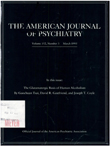Dissociative disorders in psychiatric inpatients
Abstract
OBJECTIVE: This study attempted to determine 1) the prevalence of dissociative disorders in psychiatric inpatients, 2) the degree of reported childhood trauma in patients with dissociative disorders, and 3) the degree to which dissociative experiences are recognized in psychiatric patients. METHOD: A total of 110 patients consecutively admitted to a state psychiatric hospital were given the Dissociative Experiences Scale. Patients who scored above 25 were matched for age and gender with a group of patients who scored below 5 on the scale. All patients in the two groups were then interviewed in a blind manner, and the Dissociative Disorders Interview Schedule, the Traumatic Antecedent Questionnaire, and the posttraumatic stress disorder (PTSD) module of the Structured Clinical Interview for DSM-III-R, Nonpatient Version, were administered. Chart reviews were also conducted on all patients. RESULTS: Fifteen percent of the psychiatric patients scored above 25 on the Dissociative Experiences Scale; 100% of these patients met DSM-III criteria for a dissociative disorder. These patients had significantly higher rates of major depression, PTSD, substance abuse, and borderline personality than did the comparison patients, and they also reported significantly higher rates of childhood trauma. Chart review data revealed that dissociative symptoms were largely unrecognized. CONCLUSIONS: A high proportion of psychiatric inpatients have significant dissociative pathology, and these symptoms are underrecognized by clinicians. The proper diagnosis of these patients has important implications for their clinical course.
Access content
To read the fulltext, please use one of the options below to sign in or purchase access.- Personal login
- Institutional Login
- Sign in via OpenAthens
- Register for access
-
Please login/register if you wish to pair your device and check access availability.
Not a subscriber?
PsychiatryOnline subscription options offer access to the DSM-5 library, books, journals, CME, and patient resources. This all-in-one virtual library provides psychiatrists and mental health professionals with key resources for diagnosis, treatment, research, and professional development.
Need more help? PsychiatryOnline Customer Service may be reached by emailing [email protected] or by calling 800-368-5777 (in the U.S.) or 703-907-7322 (outside the U.S.).



